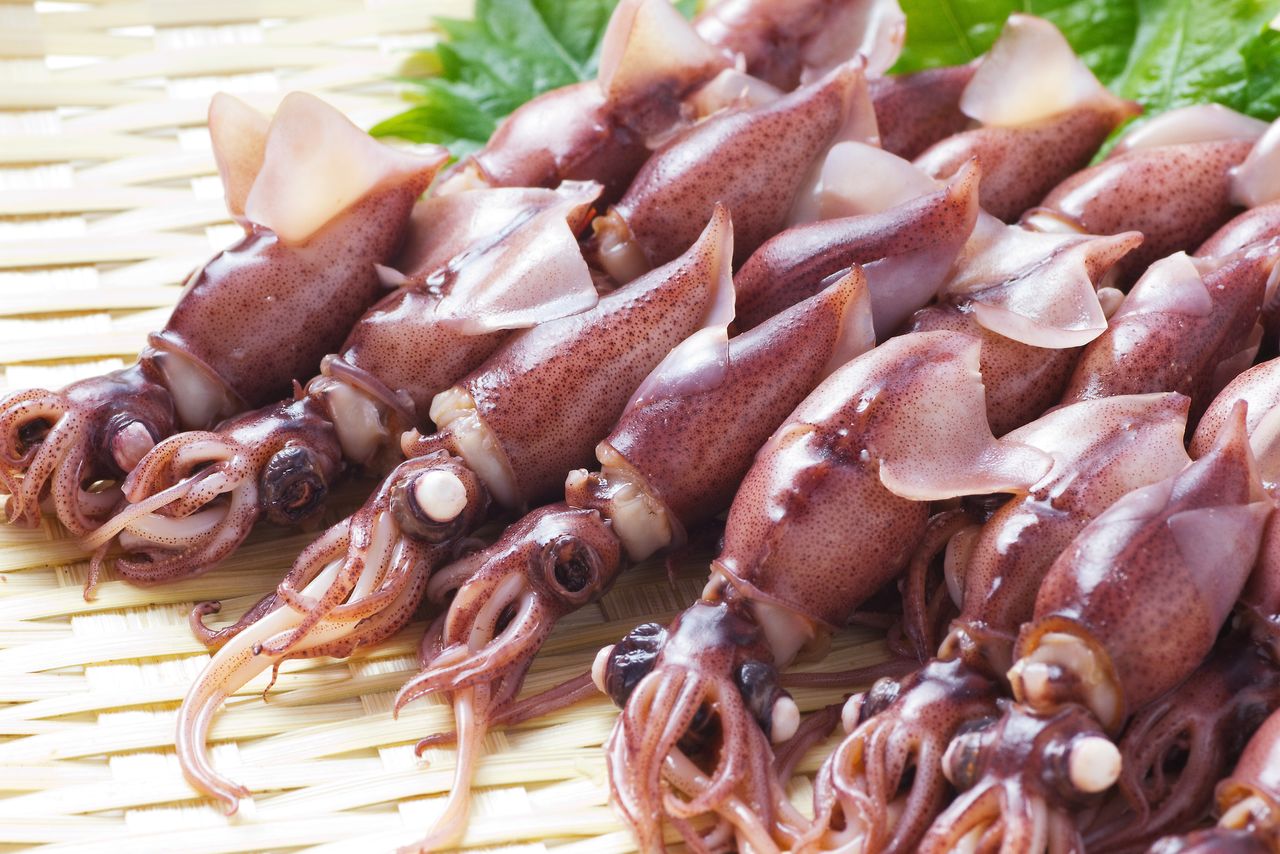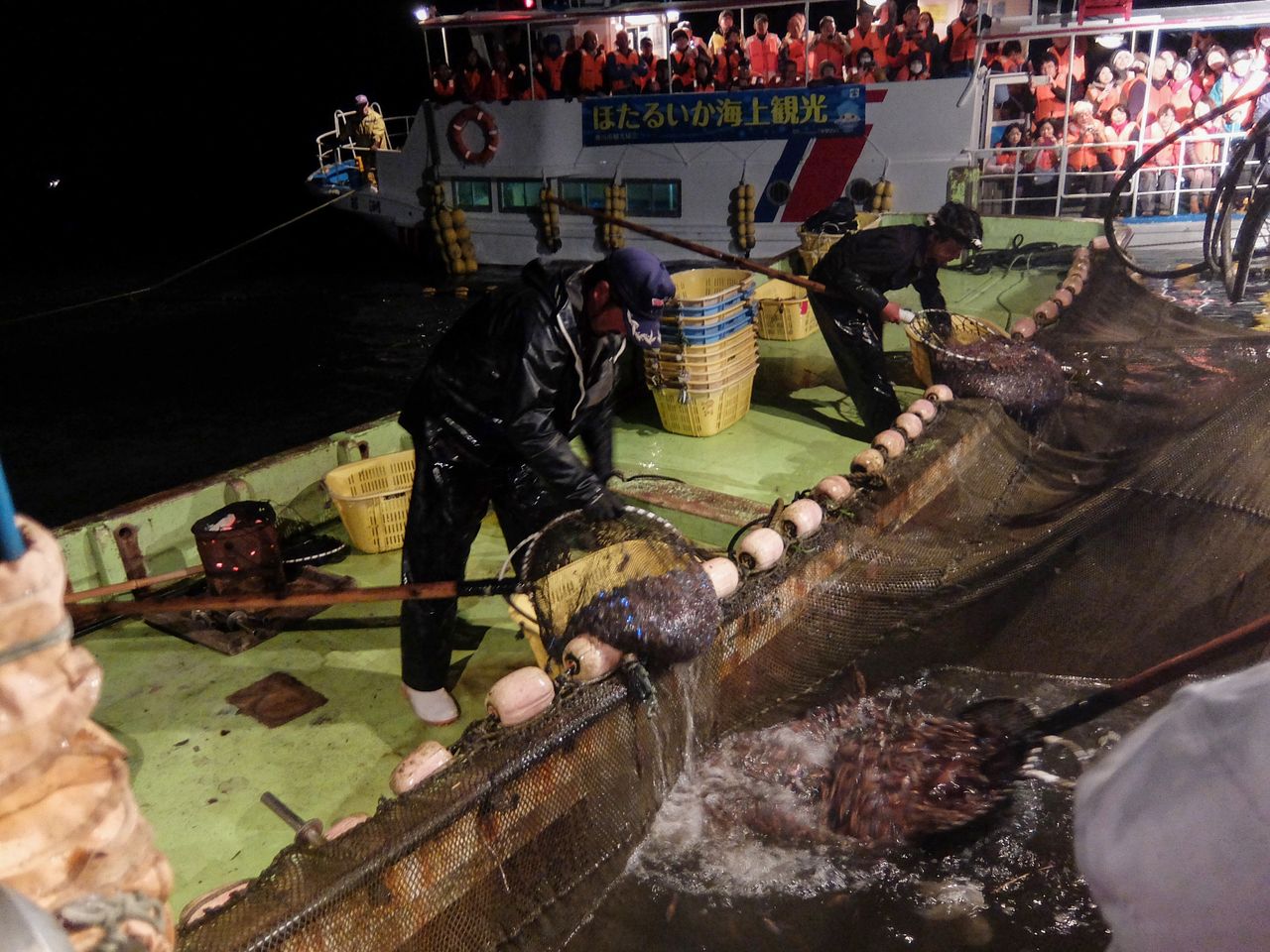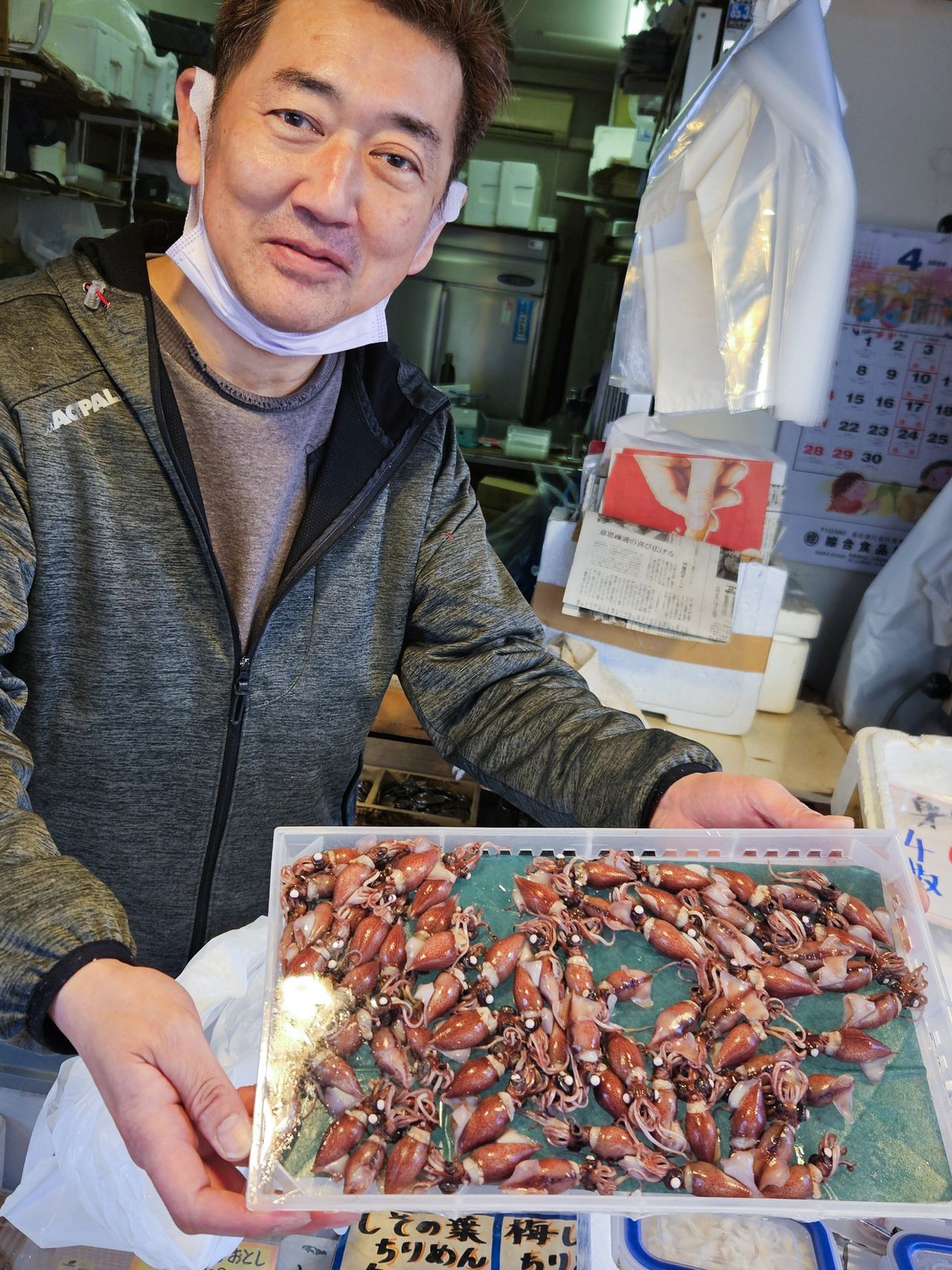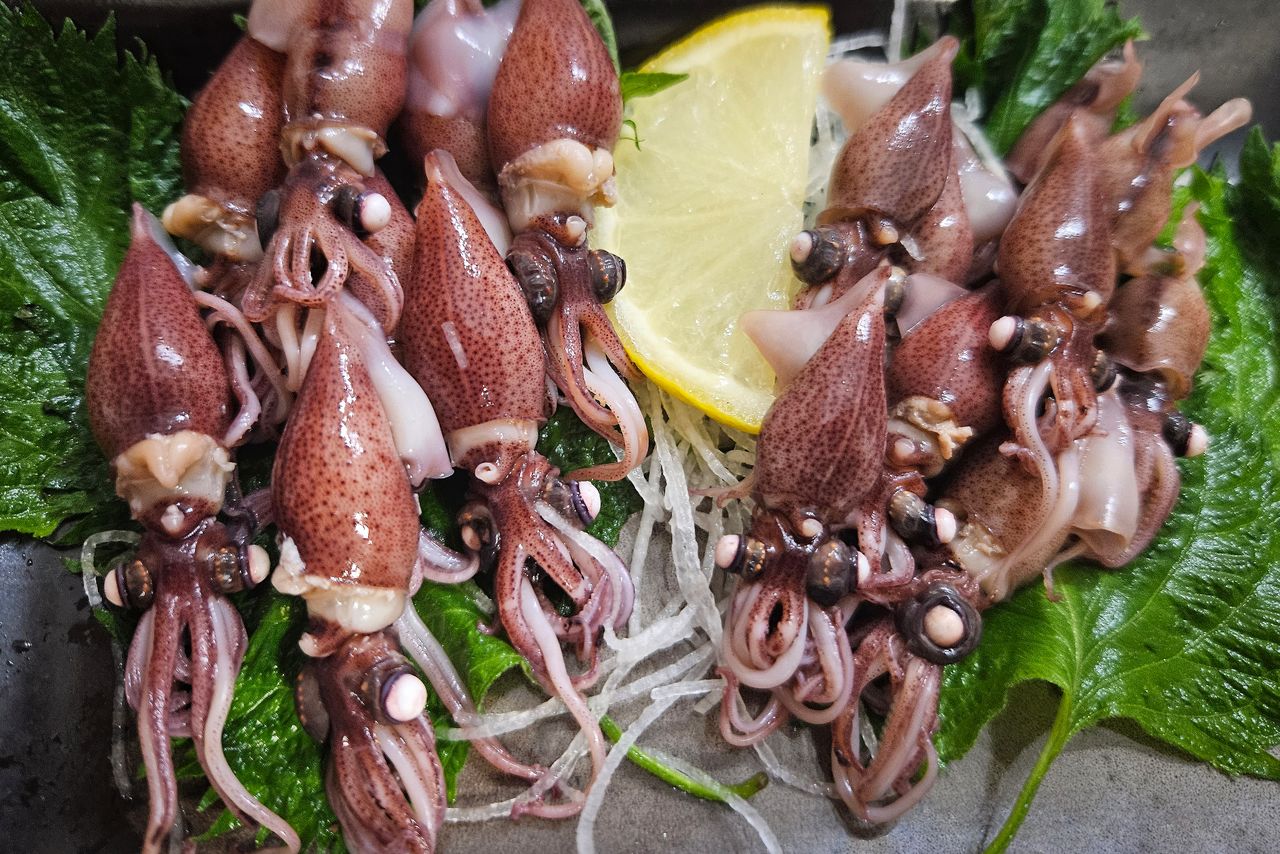
“Fireflies of the Sea”: Tiny Squid Cheaper, Meatier, More Delicious than Ever
Guide to Japan Lifestyle Food and Drink- English
- 日本語
- 简体字
- 繁體字
- Français
- Español
- العربية
- Русский
An Affordable Treat for Seafood Lovers
The annual spring catch of hotaru ika (Watasenia scintillans), a dwarf squid just 7.5 centimeters long, is breaking records this year. The haul from the season for fixed-net fishing, which began March 1 in in Toyama Bay, has already reached 1,200 tons in just a month. This represents a 17-fold increase over the 70 tons caught the same month last year, when the total catch for the season was 418 tons, the lowest figure since record-keeping began in 1953.
While no one knows whether that pace can be sustained, the Fisheries Research Lab of the Toyama Prefectural Agricultural, Forestry, and Fisheries Research Center expects that large hauls will continue up until June, pushing the in-season total catch to over 2,200 tons. This estimate is based on the state of bycatches and surveys conducted by research vessels before the start of the season.
Such abundance naturally means greatly reduced prices for the product in circulation. In early April, the wholesale price for Toyama hotaru ika at Tokyo’s Toyosu Wholesale Fish Market ranged from ¥400 to ¥700 (median price ¥500) for packages of 300 to 400 grams of boiled squid. That is 70% cheaper than prices last April, which were ¥800–¥2,300 (median ¥1,500). Wholesalers this year describe the squid as large, meaty, and flavorful.

To avoid possible parasite contamination, most hotaru ika are boiled prior to shipping to market. (© Pixta)
Toyama Top-of-Mind for Hotaru Ika
Hotaru ika, poetically named “firefly squid” for their bioluminescence, are caught in the Sea of Japan, boiled, and frozen before being shipped to all parts of the country. While squid caught in Toyama are the best-known, farther to the southwest, Hyōgo Prefecture ports such as Hamasaka and Kasumi in the Tajima region on the Sea of Japan coast actually bring in larger catches.
People tend to associate hotaru ika with Toyama because of a phenomenon called minage, when the squid “fling themselves” onto the region’s beaches. In spring, these squid, which normally live near the sea bottom in waters 200 meters deep, move to the shallows at dusk or after dark to spawn. Some of them are washed onto the shore, leaving Toyama’s beaches sparkling with millions of points of bluish light, a mesmerizing seasonal attraction. Fishing boats also offer popular tours where those on board can see masses of squid being hauled in from fixed shore nets.

Millions of squid beached on the shore glow in the dark. (© Pixta)
Fishers off Hyōgo Prefecture, meanwhile, use bottom-trawling nets, and by the time the squid are hauled up from the deep, most are too weak to give off any light as they surface. Those nets also catch both male and female squid indiscriminately, whereas in Toyama Bay only plump females ready to spawn appear near shore. Fishing grounds there are closer to processing facilities as well, so the squid can be quickly boiled and shipped to market. Toyama hotaru ika thus enjoy a reputation for superior freshness and taste.

The netted squid emit a blue light. A tour boat packed with visitors who have come to see this spectacle floats in the background. (© Jiji)
After the Earthquake, A Welcome Bounty
A major earthquake, with a peak intensity hitting the maximum 7 on Japan’s seismic intensity scale, struck the Noto Peninsula on January 1, 2024. Most of the damage occurred in the Noto area, but the disaster affected fishing ports across Toyama Bay on the eastern side of the peninsula, causing fissures and subsidence. The earthquake also altered the seabed topography, damaging bottom-trawling nets. Fishers were concerned that the disaster would affect the squid fishery, but happily, record amounts are being caught. Officials at the prefecture’s Fisheries Research Lab believe this was due to large schools of squid in the Sea of Japan migrating to Toyama Bay, attracted by favorable currents and water temperatures.
Catch volumes in the bay have never been consistent. From hauls of nearly 4,000 tons per year in the early 1990s to an average 1,300 tons per year in the past decade, catches have alternated between good and bad years. And while the 2023 catch was especially poor, that did not necessarily presage a bad haul this year, and the bumper catch was welcome news in the disaster-affected areas. Consumers are also pleased to be enjoying lower prices and grateful for the hard work of the Toyama fisheries cooperatives for getting back up and running in time for this year’s season.

Raw hotaru ika are boiled to kill off parasites. Processing facilities damaged in the earthquake raced to get back on their feet in time for the fishing season. (© Pixta)
Reasonable Prices at the Market
Many shoppers are pleasantly surprised to find meaty and inexpensive hotaru ika already on offer at fish shops now.
Availability and prices for Hyōgo squid are generally stable most years. At Tokyo’s Toyosu Wholesale Market, prices in early April ranged from ¥300 to ¥450 per package, with a median price of ¥350, close to last year’s prices. Since Hyōgo squid are cheaper than those from Toyama and distribution volumes are stable, these are the kind generally wholesaled to ordinary supermarkets.
Toyama squid, on the other hand, are mainly bought by restaurants, and high prices like last year’s would ordinarily have deterred buyers for supermarkets. But according to Toyosu Market auctioneers, thanks to this year’s good catches, “the minute the wholesale price for Toyama squid dropped to 500 yen, many supermarket buyers switched from Hyōgo squid to the Toyama product.”

A fishmonger displays large Toyama squid at his shop in the Tsukiji Outer Market. (© Kawamoto Daigo)
Enjoying Hotaru Ika
In late March, I decided to taste-test hotaru ika from both fishing grounds. The squid from Toyama, weighing around 6 grams each, were twice the weight of the Hyōgo squid. They also had a generous amount of entrails, making them rich in umami.
It is not known exactly why the hotaru ika from Toyama are larger than their Hyōgo cousins. The Fisheries Research Lab believes the difference may be due to the bay’s water temperature and the presence of plankton the squid feed on, creating appropriate conditions for them to grow larger there.

Test-tasted at home. The Toyama squid (left) were larger and meatier than their Hyōgo counterparts (right). (© Kawamoto Daigo)
Most people eat hotaru ika with vinegared miso and shōyu, but a Toyosu Outer Market fishmonger suggested adding an egg yolk with a few drops of soy sauce to mix with the squid—a tasty combination indeed. Hotaru ika can also be enjoyed as finely chopped namerō or added to chawanmushi egg custard or takikomi gohan, seasoned cooked rice. Sauteed in olive oil with garlic, the squid also makes a fine addition to pasta.
Seafood lovers can eat their fill of Toyama hotaru ika with this year’s bounty and at the same time support the earthquake-affected region through their purchases.

Hotaru ika, delicious in Japanese cuisine, also works well in pasta and other Western-style dishes. (© Pixta)
(Originally published in Japanese. Banner photo: A package brimming with hotaru ika from Toyama at the Tsukiji market. © Kawamoto Daigo.)